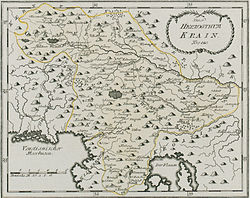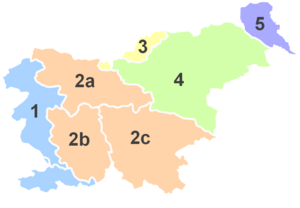Carniola
This article includes a list of general references, but it lacks sufficient corresponding inline citations. (April 2010) |
Carniola | |
|---|---|
 The Carniolan Provincial Assembly Building in Ljubljana, also the seat of the Regional Committee and the Governor of the Duchy of Carniola, today the seat of the University of Ljubljana | |
 1791 map of Carniola | |
| Coordinates: 45°52′51″N 14°04′30″E / 45.8808°N 14.0749°E | |
| Country | Slovenia |
| Elevation | 400 m (1,300 ft) |

Carniola (
Overview
The
In 1804 it became part of the newly established
Nowadays, its territory (in the extent at its dissolution) is almost entirely located in Slovenia, except for a small part in Italy, around Fusine in Valromana.[2][note 1] Carniola in its final form, established in 1815,[3] encompassed 9,904 km2 (3,824 sq mi).[4] In 1914, before the beginning of World War I, it had a population of slightly under 530,000 inhabitants, of whom 95% were Slovenes.[3]
Geography
The region was crossed by the
Nearby is the Ljubljana Marsh, and a series of hot and mineral springs which can be found at Dolenjske Toplice, Šmarješke Toplice, and Izlake.[5]
Agriculture thrived more in Upper Carniola than in Lower Carniola. The Vipava Valley was especially famous for its wine and vegetables, and for its mild climate. The average temperature was 56 °F (13 °C) in spring, 77 °F (25 °C) in summer, 59 °F (15 °C) in autumn, and 26 °F (−3 °C) in winter.
In 1910 the main railroads were the Southern, Prince Rudolf, Bohinj, Kamnik, Lower Carniola, and Vrhnika railroads. The principal cities and towns in the region were Kamnik, Kranj, Tržič, Vrhnika, Vipava, Idrija, Turjak, Ribnica, Metlika, Novo Mesto, and Vače.[5]
History
Overview
After the fall of the
The capital of Carniola, originally located at Kranj (German: Krainburg), was briefly moved to Kamnik (German: Stein) and finally to the current capital of Slovenia, Ljubljana (German: Laibach).
Chronology
- Fourth century: Germanic settlements of Herules(or Heruli).
- Fifth century: Germanic settlements of Langobards(or Lombards).
- Sixth century: Slovene settlements.
- Eighth century: Carniola a part of the Empire of Charlemagne.
- 10th century: Carniola a separate country.
- 1278: Death of Ottokar II of Bohemia. Carniola absorbed in the Habsburg dominions.
- 14th century: The province under Albert III.
- 15th–16th centuries: Ravages of the Ottomans.
- 1527–1564: Progress of the Reformation in Carniola.
- 1564: Death of Ferdinand I. Carniola under the Archduke Charles. Religious persecutions begin.
- 1763: Political administration of "Inner Austria" centralized at Graz.
- 1790: Accession of Leopold II. Partial revival of autonomy.
- 1797: First French invasion.
- 1805: Second French invasion.
- 1809: Treaty of Schönbrunn. Carniola under French rule.
- 1814: Congress of Vienna. Carniola restored to Austria.[9]
Antiquity and Middle Ages

Before the coming of the Romans (c. 200 BC), the
Carniola formed part of the
After the fall of the Western Roman Empire (476), Carniola was incorporated into Odoacer's Kingdom of Italy, and then in 493, under Theodoric, it formed part of the Ostrogothic Kingdom. Between the upper Sava and the Soča rivers lived the Carni, and towards the end of the sixth century Slavs settled the region called by Latin writers Carnia, or Carniola meaning 'little Carnia'; i.e., part of greater Carnia.[5] The Latin name was later borrowed into Slavic, becoming Kranjska,[10] and into German as Chrainmark, Krain.
The new inhabitants, to whom modern historiography frequently refers to as
March of Carniola
Carniola was governed by the Franks about the year 788, and was Christianized by missionaries from the
Several sources from the High Middle Ages suggest that there was a common Carantanian (that is, Carinthian) identity that slowly vanished after the 14th century and was replaced by a regional Carniolan identity.
In the Middle Ages the Church held much property in Carniola, and thus in 974 in Upper and Lower Carniola the
Among secular potentates, the Dukes of Meran, Gorizia, Babenberg, and Zilli held possessions given to them in fief by the patriarchs of Aquileia. The dukes governed the province for nearly half a century.[5]
Finally Carniola was given in fief with the consent of the patriarch to
Duchy of Carniola

Ottokar was defeated by
French Intermezzo


French revolutionary troops occupied Carniola in 1797, and from 1805 to 1806. Under the Treaty of Vienna, Carniola became part of the
Ecclesiastical history
In early Christian times the duchy was under the jurisdiction of the
The diocese of Ljubljana or Laibach was established by Emperor Frederick III on 6 December 1461. It was directly subject to the pope. This was confirmed by a Bull of Pope Pius II, 10 September 1462. The new diocese consisted of part of Upper Carniola, two parishes in Lower Carniola, and a portion of Lower Styria and Carinthia; the remaining portion of Carniola was attached to Aquileia, later on to Gorizia and Trieste. At the redistribution of dioceses (1787 to 1791) not all the parishes in Carniola were included in the Diocese of Ljubljana, but this was accomplished in 1833, by taking two deaneries from the Diocese of Trieste, one from Gorizia, and one parish from the Diocese of Lavant, so as to include all the territory within the political boundaries of the crownland.[5]
Austrian administration
The
The duchy was constituted by rescript of 20 December 1860, and by imperial patent of 26 February 1861, modified by legislation of 21 December 1867, granting power to the home parliament to enact all laws not reserved to the imperial diet, at which it was represented by eleven delegates, of whom two elected by the landowners, three by the cities, towns, commercial and industrial boards, five by the village communes, and one by a fifth curia by secret ballot, every duly registered male twenty-four years of age has the right to vote. The home legislature consisted of a single chamber of thirty-seven members, among whom the prince-bishop sits ex-officio. The emperor convened the legislature, and it is presided over by the governor. The landed interests elected ten members, the cities and towns eight, the commercial and industrial boards two, the village communes sixteen. In 1907, instead of these rules, universal and equal suffrage for all men was introduced. The business of the chamber was restricted to legislating on agriculture, public and charitable institutions, administration of communes, church and school affairs, the transportation and housing of soldiers in war and during manoeuvres, and other local matters. The land budget of 1901 amounted to 3,573,280 crowns ($714,656).[5]
Modern era
In 1918, the duchy ceased to exist and its territory became part of the newly formed
See also
- Battle of Sisak
- Duchy of Carniola
- Flag of Slovenia
- The Glory of the Duchy of Carniola—Encyclopedia
- History of Slovenia
- Inner Austria
- Johann Weikhard von Valvasor
- March of Carniola
Notes
- ^ In the extent at its dissolution.
References
- ^ "Slovenski pravopis 2001: Kranjska".
- ISBN 9788611150338.
- ^ a b Pipp, Lojze (1935). "Razvoj števila prebivalstva Ljubljane in bivše vojvodine Kranjske" [The Development of the Number of Population of Ljubljana and the Former Duchy of Carniola]. Kronika Slovenskih Mest (in Slovenian). 2 (1). City Municipality of Ljubljana.
- ISBN 9788611150338.
- ^ a b c d e f g h i j k l m n o p
 One or more of the preceding sentences incorporates text from a publication now in the public domain: Krmpotić, Martin Davorin (1910). "Krain". In Herbermann, Charles (ed.). Catholic Encyclopedia. Vol. 8. New York: Robert Appleton Company.
One or more of the preceding sentences incorporates text from a publication now in the public domain: Krmpotić, Martin Davorin (1910). "Krain". In Herbermann, Charles (ed.). Catholic Encyclopedia. Vol. 8. New York: Robert Appleton Company.
- ^ Minahan, James. 2000. One Europe, Many Nations: A Historical Dictionary of European National Groups. Westport, CT: Greenwood Press, p. 633.
- ^ Staab, Franz. 1976. Ostrogothic Geographers at the Court of Theodoric the Great: A Study of Some Sources of the Anonymous Cosmographer of Ravenna. Viator: Medieval and Renaissance Studies 7: 27–64, p. 54.
- ^ Plut-Pregelj, Leopoldina & Carole Rogel. 2010. The A to Z of Slovenia. Lanham, MD: Scarecrow Press, p. 48.
- ^ Prothero, GW; Great Britain. Foreign Office. Historical Section (1920). Carniola, Carinthia and Styria. Peace handbooks. London: H.M. Stationery Office. p. 11. Retrieved 5 June 2014.
- ^ Snoj, Marko (2009). Etimološki slovar slovenskih zemljepisnih imen [Etymological dictionary of Slovenian geographical names]. Ljubljana: Modrijan. pp. 210–211.
- ^ See: Paris Peace Treaties, 1947
Further reading
- Dimitz, August (2013) [1875], History of Carniola: From Primeval Times to the death of Emperor Frederick III (1493), vol. I, Witter, Andrew J., translator, Slovenian Genealogical Society International, ISBN 978-1-48360-408-4
- Dimitz, August (2013) [1875], History of Carniola: From the Accession of Maximilian I (1493) to the Year 1813, vol. II, Witter, Andrew J., translator, Slovenian Genealogical Society International, ISBN 978-1-48360-410-7
- Dimitz, August (2013) [1875], History of Carniola: From the Accession of Archduke Karl to Leopold I (1564–1657), vol. III, Witter, Andrew J., translator, Slovenian Genealogical Society International, ISBN 978-1-48360-412-1
- Dimitz, August (2013) [1875], History of Carniola: To the end of French Rule in Illyria (1813), vol. IV, Witter, Andrew J., translator, Slovenian Genealogical Society International, ISBN 978-1-48360-417-6



